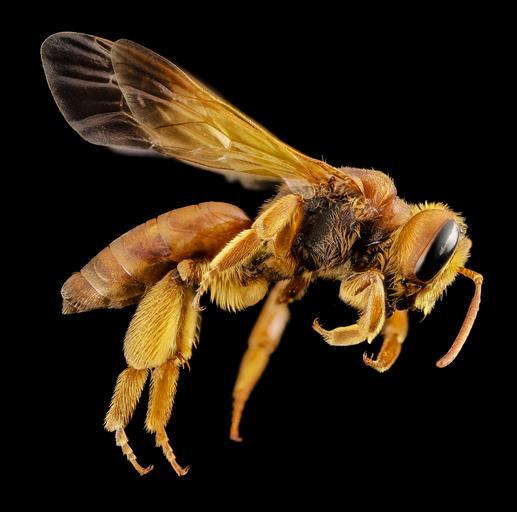MAKE A MEME
View Large Image

| View Original: | Andrena_oman,_f,_oman,_side_2014-10-11-16.25.26_ZS_PMax.jpg (3441x3409) | |||
| Download: | Original | Medium | Small | Thumb |
| Courtesy of: | www.flickr.com | More Like This | ||
| Keywords: bee bees andrena andrenidae oman arabian peninsula arabianpeninsula peninsula arabian asia orange black-tipped blacktipped wing leg макросъемка makro マクロ природа natur 自然 الطبيعة 大自然 naturaleza natura насекомое insekt الحشرة 昆蟲 insectos animal black background photo border macro Andrena species, Black-tipped Andrena, specimen collected by Jason Gibbs in Oman Evolution has blessed the genus Andrena with over 1500 different species, making it the second richest of all bee genera (Hairy-tongue Bees, Lasioglossum, are first). Despite all this abundance of species they have not traveled very far south and do not occur in either South America or Australia and are relatively rare in Africa. So what fun is it to find that Jason Gibbs on an expedition to Oman has found an Andrena where no Andrena had been recorded before? Sadly, at this point we don’t know if this is a species of Andrena new to science or something previously described but not documented. Given that several Andrena are known from Saudi Arabia and many are known from Iran, one would suspect that this species might be identifiable, it certainly is a very distinctive looking bee. Unlike the majority of Andrena, but perhaps more common in extremely dry areas, this bee is not the normal black color but largely a lovely orange-red. ~~~~~~~~~~{{{{{{0}}}}}}~~~~~~~~~~ All photographs are public domain, feel free to download and use as you wish. Photography Information: Canon Mark II 5D, Zerene Stacker, Stackshot Sled, 65mm Canon MP-E 1-5X macro lens, Twin Macro Flash in Styrofoam Cooler, F5.0, ISO 100, Shutter Speed 200 Further in Summer than the Birds Pathetic from the Grass A minor Nation celebrates Its unobtrusive Mass. No Ordinance be seen So gradual the Grace A pensive Custom it becomes Enlarging Loneliness. Antiquest felt at Noon When August burning low Arise this spectral Canticle Repose to typify Remit as yet no Grace No Furrow on the Glow Yet a Druidic Difference Enhances Nature now -- Emily Dickinson Want some Useful Links to the Techniques We Use? Well now here you go Citizen: Basic USGSBIML set up: www.youtube.com/watch?v=S-_yvIsucOY USGSBIML Photoshopping Technique: Note that we now have added using the burn tool at 50% opacity set to shadows to clean up the halos that bleed into the black background from "hot" color sections of the picture. www.youtube.com/watch?v=Bdmx_8zqvN4 PDF of Basic USGSBIML Photography Set Up: ftp://ftpext.usgs.gov/pub/er/md/laurel/Droege/How%20to%20Take%20MacroPhotographs%20of%20Insects%20BIML%20Lab2.pdf Google Hangout Demonstration of Techniques: plus.google.com/events/c5569losvskrv2nu606ltof8odo or www.youtube.com/watch?v=4c15neFttoU Excellent Technical Form on Stacking: www.photomacrography.net/ Contact information: Sam Droege [email protected] 301 497 5840 Andrena species, Black-tipped Andrena, specimen collected by Jason Gibbs in Oman Evolution has blessed the genus Andrena with over 1500 different species, making it the second richest of all bee genera (Hairy-tongue Bees, Lasioglossum, are first). Despite all this abundance of species they have not traveled very far south and do not occur in either South America or Australia and are relatively rare in Africa. So what fun is it to find that Jason Gibbs on an expedition to Oman has found an Andrena where no Andrena had been recorded before? Sadly, at this point we don’t know if this is a species of Andrena new to science or something previously described but not documented. Given that several Andrena are known from Saudi Arabia and many are known from Iran, one would suspect that this species might be identifiable, it certainly is a very distinctive looking bee. Unlike the majority of Andrena, but perhaps more common in extremely dry areas, this bee is not the normal black color but largely a lovely orange-red. ~~~~~~~~~~{{{{{{0}}}}}}~~~~~~~~~~ All photographs are public domain, feel free to download and use as you wish. Photography Information: Canon Mark II 5D, Zerene Stacker, Stackshot Sled, 65mm Canon MP-E 1-5X macro lens, Twin Macro Flash in Styrofoam Cooler, F5.0, ISO 100, Shutter Speed 200 Further in Summer than the Birds Pathetic from the Grass A minor Nation celebrates Its unobtrusive Mass. No Ordinance be seen So gradual the Grace A pensive Custom it becomes Enlarging Loneliness. Antiquest felt at Noon When August burning low Arise this spectral Canticle Repose to typify Remit as yet no Grace No Furrow on the Glow Yet a Druidic Difference Enhances Nature now -- Emily Dickinson Want some Useful Links to the Techniques We Use? Well now here you go Citizen: Basic USGSBIML set up: www.youtube.com/watch?v=S-_yvIsucOY USGSBIML Photoshopping Technique: Note that we now have added using the burn tool at 50% opacity set to shadows to clean up the halos that bleed into the black background from "hot" color sections of the picture. www.youtube.com/watch?v=Bdmx_8zqvN4 PDF of Basic USGSBIML Photography Set Up: ftp://ftpext.usgs.gov/pub/er/md/laurel/Droege/How%20to%20Take%20MacroPhotographs%20of%20Insects%20BIML%20Lab2.pdf Google Hangout Demonstration of Techniques: plus.google.com/events/c5569losvskrv2nu606ltof8odo or www.youtube.com/watch?v=4c15neFttoU Excellent Technical Form on Stacking: www.photomacrography.net/ Contact information: Sam Droege [email protected] 301 497 5840 | ||||